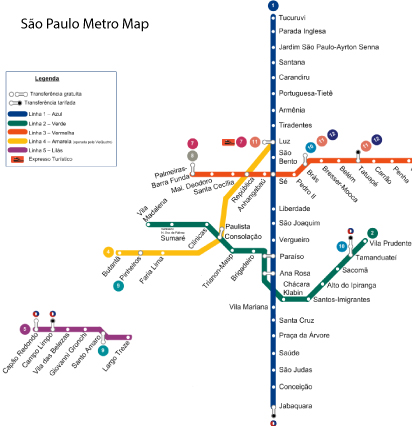The São Paulo Metro (Metrô de São Paulo) stands as Latin America’s largest and most efficient urban rail network, serving over 4.6 million passengers daily across Brazil’s bustling economic capital. Whether you’re a tourist exploring the city or a resident navigating daily commutes, understanding this comprehensive transit system is essential for efficient urban mobility.
Network Overview and Coverage
The São Paulo Metro operates six color-coded lines spanning approximately 104 kilometers with 89 stations throughout the metropolitan area. The system includes:
- Line 1 (Blue): Connects Jabaquara to Tucuruvi, serving the city center
- Line 2 (Green): Runs from Vila Madalena to Vila Prudente
- Line 3 (Red): Links Corinthians-Itaquera to Palmeiras-Barra Funda
- Line 4 (Yellow): Connects Butantã to Luz station
- Line 5 (Lilac): Serves Capão Redondo to Chácara Klabin
- Line 15 (Silver): The monorail system serving eastern São Paulo
This extensive network strategically connects major business districts, shopping centers, universities, and residential areas, making it an indispensable transportation option for millions of paulistanos.
Ticketing and Payment Options
The São Paulo Metro uses the integrated Bilhete Único (Single Ticket) system, allowing seamless transfers between metro lines, buses, and urban trains. Passengers can purchase single-journey tickets or load credits onto reusable cards at station vending machines or ticket counters.
Current fare options include:
- Single metro journey tickets
- Integrated tickets allowing transfers to buses and trains
- Monthly unlimited passes for regular commuters
- Student discounts with proper identification
Payment methods accept cash, debit cards, and credit cards at most stations, with contactless payment increasingly available across the network.
Operating Hours and Frequency
The São Paulo Metro operates Monday through Friday from 4:40 AM to midnight, with extended weekend hours on Saturdays until 1:00 AM and Sundays until midnight. During peak hours (7:00-9:00 AM and 5:00-7:00 PM), trains typically arrive every 2-3 minutes, ensuring minimal waiting times despite heavy passenger volume.
Accessibility and Safety Features
The metro system prioritizes accessibility with elevator access at most stations, tactile floor guidance for visually impaired passengers, and designated spaces for wheelchair users in every train car. Security measures include 24/7 surveillance, emergency communication systems, and regular patrol by metro security personnel.
Tips for Efficient Travel
To maximize your São Paulo Metro experience:
- Avoid peak hours when possible to reduce crowding
- Keep belongings secure and remain aware of your surroundings
- Download official metro apps for real-time updates and route planning
- Allow extra time during major events or holidays
- Consider purchasing integrated tickets if combining metro travel with buses
Connecting to Major Attractions
The metro efficiently connects visitors to São Paulo’s key destinations, including Vila Madalena’s nightlife district, the historic city center, major shopping areas like Paulista Avenue, and cultural attractions throughout the metropolitan area.
The São Paulo Metro represents more than just transportation—it’s the circulatory system of South America’s largest city, enabling economic activity and connecting diverse communities across this vibrant metropolis.

